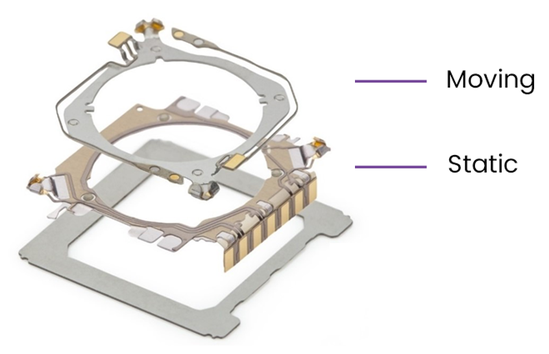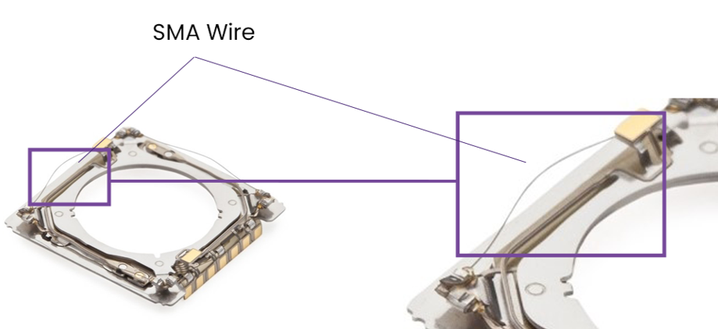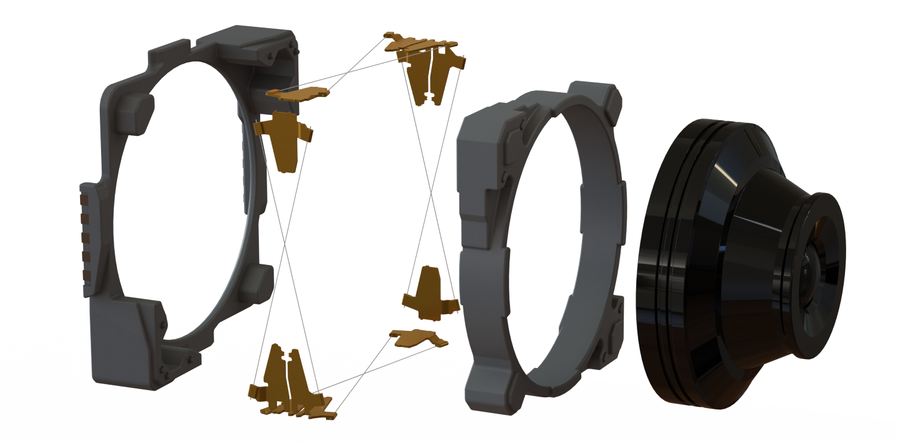3 Nov 2023
Behind the Lens: The essential components of SMA actuators and how they shape our smartphone cameras
By Robin Eddington, Head of Product Design
SMA (Shape Memory Alloy) actuators are transforming precision motion control in compact optical devices. At first glance, they might seem intricate. Let's break down the key components of a Cambridge Mechatronics Ltd (CML) SMA actuator and understand its core operations for optical image stabilisation (OIS) and autofocus (AF).
Static component
Every SMA actuator starts with a static component, often affixed to another element in the product, such as a handset body or the smartphone PCB. Acting as a foundation, it anchors the entire actuator structure.
Moving component
Counter to the static is the moving component. This dynamic segment is where the action happens, whether it's adjusting a camera lens or image sensor, moving a fluidics valve or interacting with an adjacent system in a device.
Figure 1: Exploded view of a 4-wire SMA actuator design for optical image stabilisation
The heart - SMA actuation units
The connection between the static and moving components is the SMA actuation unit. This might be in a format with the SMA wires directly attached. Alternatively, the SMA wires are linked to a flexure, adjusting the force and stroke of the primary wire. Typically operating in pairs that heat and cool in opposition, these SMA wire-linked units are the pulse of the actuator, enabling the desired motion.

Figure 2: Close-up of SMA wire. The SMA wire is in a ‘slack’ position, i.e. it’s not powered and so appears loose. When heated, the wire shortens and tightens.
Attachment – crimp components
Reliable SMA wire attachment is vital. SMA wire crimping, a method pioneered and perfected by CML, has become the standard for joining fine SMA wires to actuators. It ensures a strong bond, both mechanically and electrically.
Mechanical end-stops
Mechanical end-stops limit the displacement of the moving part. They are the safety harness which ensures the moving part cannot overextend when the actuator (within a device) is dropped and experiences shock. The correct design is critical to ensure reliability of the SMA wire and other delicate components.
Motion constraints
Bearings and flexures serve as the rails, guiding the movement. For example, a helical autofocus (AF) product has a helical bearing, ensuring only translation in the lens axis under controlled rotation. By limiting degrees of freedom, we optimise power, assembly efficiency and cost.
Driving and controlling SMA wires
Beyond the mechanical lies the software soul of SMA actuators. The driver and control firmware are crucial. They not only control the length of the SMA wire but also understand its position, guiding the actuator’s movements with precision.
The CM824 IC chip is critical to the SMA actuator system, serving as its brain by ensuring precise and efficient movement. It enhances accuracy, optimises power consumption, provides invaluable real-time feedback, offers broad device compatibility, and ensures scalability. This chip is not just an accessory but a central component that elevates the performance and future readiness of the SMA actuator.
Actuator variations
Combining all the components into a single actuator, different products are tailored for various applications, with CML’s 8-wire, 4-wire and 2-wire configurations standing out prominently.
8-wire actuator technology:
Multi-directional Control: The 8-wire configuration offers unparalleled versatility. It currently offers three degrees of controlled translation (X, Y, & Z) and rotation (Rx, Ry, Rz) on the moving part. This multifaceted movement control makes it ideal for applications requiring comprehensive positional adjustments and its flexibility enables it to be the basis of both the sma Lens shift af+ois and sma Module Tilt ois (gimbal-style stabilisation) products.
Simplified Design: Despite its multi-wire system, the 8-wire actuators boasts a clean and efficient design. Without the need for external motion constraints, the SMA wires independently determine the position of the moving component. This self-sufficiency results in a streamlined and efficient design, minimising components, simplifying manufacture and reducing cost.
Precise Positioning: Due to its frictionless mechanics and robust control mechanism, the 8-wire actuators ensures precise placement and orientation, essential in industries where precision is paramount, such as in advanced robotics or OIS and AF for high-definition camera modules.

Figure 3: Exploded view of an SMA Lens Shift AF+OIS actuator design with a camera lens attached
4-wire actuator technology:
Specialized movement: The 4-wire actuator design is adept at shifting along the X & Y axes and can provide roll around the Z axis. By focusing on these dimensions, it offers a specialised solution for tasks such as lateral (shift) OIS adjustments in camera sensors and lenses.
Incorporation of motion constraints: This variant introduces motion constraints in the form of planar bearings, restricting the movement to a 2D plane. This design choice creates a stable, high load-bearing platform which can support large lenses, and heavy VCM AF and Variable Aperture actuators without compromising performance.
Versatile, compact and efficient: The 4-wire is a versatile platform of ultra-slim design. This allows it to be seamlessly combined with a separate AF unit to provide 3 axes of translation or to fit neatly around an image sensor, controlling its shift and roll. With only four wires to manage, control can be simplified and power consumption minimised, making it highly suitable for portable electronics.
In summary
From the dynamic moving parts to the advanced control algorithms, SMA actuators are a testament to engineering ingenuity. As smartphones and compact electronics continue to evolve, a deep understanding of how to manipulate these building blocks and control the SMA wire ensures we stay at the forefront of innovation.
Both the 8-wire and 4-wire SMA actuator technologies cater to distinct needs in the ever-evolving optics industry. Whether it's the broad versatility of the SMA Lens Shift AF+OIS or the focused and compact efficiency of the SMA Lens Shift OIS, these technologies demonstrate CML’s platform designs for SMA actuators are adaptable and vital components in modern optical device design.
About CML: Cambridge Mechatronics Limited (CML) is a world-leading developer of mechanical, optical, electrical, silicon, and software designs for system-level solutions using its Shape Memory Alloy (SMA) platform technology. ACTUATOR SOLUTIONS based on SMA wire (thin as hair) can be controlled to submicron accuracy. These actuators are particularly suited to applications requiring high precision and force levels, in a fast, compact, and lightweight design.
For more details about SMA technology and Cambridge Mechatronics, please GET IN TOUCH.
